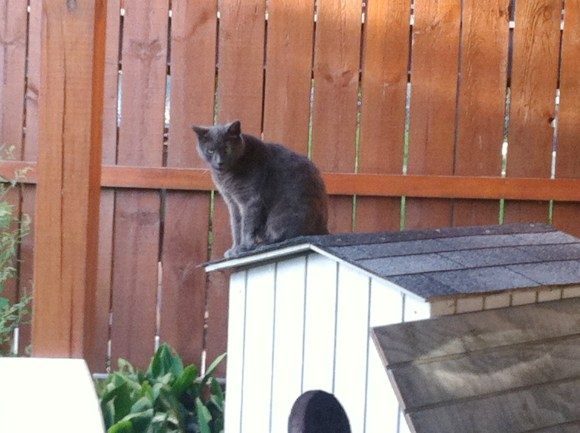RIP Zombie Cat
Zombie Cat from the V Colony got her name from her feeders because according to them, she was always sick.
She definitely had chronic upper respiratory infections, but two years ago there were also other things wrong with her. She had sores behind her ears, and her fur looked like it was coming out, almost like molting.

It took months, but I was finally able to re-trap her, and ended up trapping a few new cats and another sick cat from this colony at the same time. During this process, Jim came out to help me. My TNR friend, Dave H, also came out to hep me. I tried a drop trap even for the first time. It was indeed quite a process, because the feeders would not stop feeding. But I finally re-trapped her the good old-fashioned way – at 3am with sardines in oil for bait in a Tru-catch trap because she was finally hungry enough to go in.
Zombie got a dental, and was treated for URI with three rounds of antibiotics. She was inside with me receiving multiple medications for almost two months. The entire time she acted feral. I was able to confine her in this ingenious feral cat recovery lounge that Dave made for this purpose. Zombie did well in there.

But I could tell confinement was stressful. She did not look like herself after awhile. I did not want to break her spirit. The vet said he did all he could for her so I let her go even though she was still congested, but still much better. She seemed to thrive outside again, always with the same grumpy look on her face. She was reunited with her friends – this colony is made up of 15 cats currently, all TNR’d and all most likely born in that yard. I was happy to see her grumpy face – it meant she was feral and didn’t want human contact, just maybe some food.

In fact, no matter how sick she was, Zombie loved food. She was always first in line for it, and the other cats complied. She was indeed an alpha female.

At the beginning of February I visited the V Colony with some journalists doing a story on feral cats and TNR. Zombie was sitting on the steps and let me touch her for the first time. I knew then something was very wrong with her then. You can see her in the video.

That was the last time I saw Zombie. By the time I got back with a carrier to get her to the vet, she was gone. I asked the feeders if they could let me look in their yard and trap. They refused. I did go back several times looking for her, but never saw her again.
Last week the feeder brought Zombie’s body to Tree House to be disposed of properly. They found her in their yard just like I thought they would. Her body was too decomposed to do a necropsy. I only know this because Tree House told me since they were also in contact with the feeder.
Zombie’s life and story taught me a lot. She showed me her resilience and will to survive, and I hope the vet care made her last year a little bit better. I will always think of her when I use the recovery lounge for another feral. I will always think of her when faced with adversity and resistance when trying to help a colony. I will always think of her because I still feel guilty I couldn’t help her ultimately. That I was prevented to help her hurts more, but it’s the reality sometimes of doing TNR. We do the best we can to help these animals. Perhaps Zombie died on her own terms regardless, and that was best for her. Maybe the vet care just prolonged the inevitable. I don’t know.
Rest in peace, Zombie, you no longer have to suffer being sick here anymore.















































You were the best mom ever :)))) Sad people who were feeding did not want to help more, especially when you were doing the work.
Thank you , xo
Thank you for the kind words, Kelly. It means a lot to me.